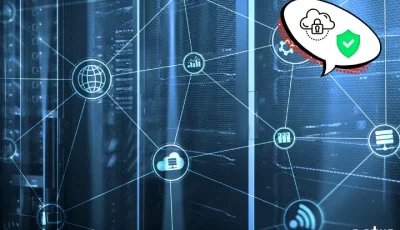“Cloud App Security” refers to a collection of tools developed to improve the safety of cloud-based software and services. With the increasing usage of cloud computing, it is more important than ever for organizations to take measures to keep their data and users secure.
This service provides various tools to deal with numerous types of threats. To begin with, it offers insight into cloud applications, making it possible for businesses to discover all of the cloud apps in use, regardless of whether or not they are authorized. As a result, IT departments can better assess the threats posed by these programs.
Cloud App Security has built-in DLP safeguards to protect sensitive information. Data flow within cloud apps is scanned and monitored to ensure sensitive data is not leaked or shared without authorization.
The service uses cutting-edge methods for detecting risks and cyberattacks through anomalous monitoring, guaranteeing rapid responses and corrections.
Key Elements of Cloud App Security
1. Identity and Access Management (IAM)
Identity and Access Management (IAM) is a critical component of cloud app security. IAM regulates who has access to and what users can do with cloud apps.
Strong IAM policies and practices must be in place to stop unauthorized access to cloud apps. IAM is heavily used for security in services that do not reveal any underlying infrastructure.
SSO is a valuable method for centralizing access for many users and services.
Although using SSO to log into public cloud accounts is unquestionably the best practice, users may have multiple roles that span different cloud accounts, making it challenging to map SSO users to IAM roles.
2. Data Encryption
Data encryption makes it difficult for unauthorized users to access data stored in cloud apps.
Several encryption algorithms, such as RSA, AES, DES, etc., can protect data.
Symmetric encryption is the most widely used encryption algorithm.
Symmetric encryption uses the same key to encrypt and decrypt data. The key can be either a shared secret key or a public key.
3. Secure Coding Practices
Human codes are prone to errors and require a set of secure coding practices and multiple code analysis and debugging steps to develop a secure cloud application.
While some code flaws are harmless, others lead to app vulnerabilities.
Applying code analysis and performing penetration tests can reveal standard holes. The app code can be secured.
Some of the most critical secure coding practices include:
- Using strong passwords and security practices
- Making sure that all code is examined for security flaws
- Using fast coding tools and frameworks
- Keeping up-to-date with the latest security vulnerabilities
4. Secure APIs
Data exchanged between applications can be safeguarded with the aid of certain APIs.
APIs can be used for various tasks, including retrieving data from databases, sending data to be stored there, pushing jobs to a queue, etc.
A secure API depends on how well its code is written, and for building a safer API, SDLC can be applied in the development cycle.
5. Secure Configuration Management
The processes used to create a cloud environment where all infrastructure and application elements can communicate and function effectively are known as cloud configurations.
Secure configuration management helps to ensure that cloud apps are configured correctly and that security patches are applied promptly.
Using configuration management tools, automated configuration management tools, and manual configuration management processes, secure cloud applications can guarantee secure configuration management.
6. Logging and Monitoring
Logging and monitoring are also crucial for security management in the cloud. Logging helps track user activity in cloud apps. Monitoring helps identify security threats and vulnerabilities.
This is important to get complete visibility into the cloud environment and detect any security issues or what might have caused a breach.
Logging and monitoring enable logging for cloud resources like API calls, console logins, resource access, etc. It also allows for setting up alerts and notifications for critical events.
7. Compliance and Regulatory Compliance
A lack of compliance with strict laws and rules can lead to legal challenges, penalties, fines, and other negative ramifications.
Some examples include HIPAA for healthcare data, PCI DSS for credit card data, GDPR for personal data of EU citizens, FedRAMP for US government data, and ISO 27001 for information security management.
Compliance is also an essential part of the GRC framework that ensures security is institutionalized within the organization.

Why is cloud app security essential for your business?
1. Data Protection
Companies today produce, gather, and store enormous amounts of data every second, from less sensitive data like behavioral and marketing analytics to susceptible business or personal customer data.
Cloud apps contain sensitive data like customer information, employee records, intellectual property, etc.
Proper security controls must be in place to protect this data from unauthorized access, theft, or cyberattacks.
Any data breach can have serious consequences, including legal penalties and a loss of customer trust.
Cloud app security is essential for protection against data loss or leaks to avoid financial loss, reputational damage, and disruption in business continuity.
2. Regulatory Compliance
Regulatory compliance is the discipline and procedure to ensure a business complies with any laws or regulations imposed by voluntarily adopted industry standards in its jurisdiction.
Cloud app security is necessary to implement compliance controls and meet critical requirements around data protection, audits, etc.
Most industries have data security and privacy regulations like HIPAA, GDPR, PCI DSS, etc., to ensure compliance.
Businesses need to comply with relevant regulations to avoid legal penalties and fines.
When a business violates its regulatory obligations, it may face legal and regulatory repercussions, reputational harm, and regulatory investigations.
3. Protection Against Cyber Threats
Even today, only some organizations have access to secure cloud applications. Hence the breaches and attacks.
Businesses and their data are susceptible to cyber threats because of some fundamental challenges and obstacles.
Cloud apps are prone to cyber threats like malware, phishing, account hijacking, DDoS attacks, etc.
Cloud security protects the servers from these attacks or emerging threats and vulnerabilities by monitoring and disseminating them.
Robust access controls, security monitoring, and other safeguards are required for businesses to protect themselves from these risks.
Any successful attack can disrupt operations, steal data, and damage the company’s reputation.
4. Brand Reputation and Customer Trust
The highly dynamic, dispersed, and opaque nature of cloud computing makes trust management a significant challenge.
Robust cloud application security solutions are the key to building and maintaining customer loyalty and trust.
Data breaches, cyberattacks, and non-compliance with regulations can severely damage a company’s reputation and brand image, compromising customer loyalty.
The security of customer data and systems is integral to maintaining customer confidence.
Cloud app security enables businesses to safeguard customer data, comply with regulations, manage identities securely, identify threats early, and provide the visibility and reporting required to win over customers and protect their brand’s reputation.
5. Scalability and Flexibility
Cloud-based application security easily scales with cloud computing services.
A growing business must be flexible enough to secure new apps deployed frequently.
This scalability and flexibility are possible only with an automated and standardized cloud application security framework.
The centralization of application security in cloud computing makes it simple to integrate new features and applications as needs change without compromising the safety of the data.
In times of high traffic, cloud app security can scale up to offer more protection when a cloud solution is upgraded and scale down to provide less protection when the volume of traffic drops.
6. Collaboration and Remote Workforce
Cloud apps enable collaboration across remote teams but introduce additional security risks due to a lack of physical controls.
Today, insider threats, malware, ransomware, credential compromise, email phishing, consent phishing, application-based attacks, and malware are the primary sources of collaboration-related threat vectors.
The balance between security and productive collaboration is essential for ensuring maximum productivity in remote and hybrid work scenarios.
Advanced identity and access management, data loss prevention, and other techniques are needed to secure cloud apps for remote collaboration. An excellent cloud app security implementation makes this possible.
How to secure your Cloud applications
1. Use Strong Authentication
Authentication is essential in protecting applications against unwanted entry to the premises or system.
Hackers can easily manipulate someone using social engineering or fake websites into disclosing their credentials.
Using robust authentication mechanisms like multi-factor authentication adds an extra layer of security for user logins.
Companies should encourage employees to create secure passwords, follow the best policies, and change them frequently.
Secure cloud applications can use biometric authentication, smart cards, tokens, or one-time passwords to ensure that only authorized users can access the application.
2. Secure Access Control
Access control involves managing who has permission to access what resources within a secure cloud application.
After a user or person has been identified or authenticated, it is essential to establish the granted privileges.
Secure access control allows businesses to limit unauthorized user access while allowing enough access to ensure efficient workplace operations.
Role-based access control (RBAC) or attribute-based access control (ABAC) mechanisms must be implemented to guarantee that users are only given access to the required resources to complete their tasks.
Businesses can gain macro-level visibility into their data and user behavior with access control in cloud app security.
3. Encrypt Data
In cloud-based application security, data encryption is critical to protecting sensitive data from unauthorized access.
Encryption is another vital way to ensure application security in cloud computing. It entails transforming data into a format an unauthorized user cannot easily understand.
Encryption can be applied to data in transit and at rest, ensuring the data is protected from cyberattacks or data breaches.
Encrypting data makes it even more difficult for attackers to access the data, even if they can access the cloud environment.
4. Perform Regular Vulnerability Assessments and Penetration Testing
Penetration testing and vulnerability assessments are two types of vulnerability testing methods to achieve a complete vulnerability analysis within the same area of focus.
Regular vulnerability assessments and penetration testing are essential to identifying and fixing security weaknesses in cloud-based applications.
Depending on the cloud service used and the provider, different manual methods, cloud penetration testing methodologies, and cloud pentesting tools might be employed.
Regular testing can help ensure that cloud applications are always secure and protected from present and emerging threats and vulnerabilities.
By performing regular vulnerability assessments and penetration testing, businesses can stay ahead of the curve and protect their cloud applications from attack.
5. Backup and Disaster Recovery
Having a plan for recovering applications in the event of an attack or natural disaster is what backup and disaster recovery refer to.
Application security in cloud computing must have a backup and disaster recovery plan in place. A copy of the data should be stored securely for emergencies.
Regular backups should be taken and stored in one or more locations, and disaster recovery plans should be tested to ensure they are effective.
Recovery time objectives (RTO) and Recovery points (RPO) must be clearly defined while making a disaster recovery plan.
6. Enable Logging and Monitoring
The practice of cloud security monitoring involves constantly scanning both virtual and physical servers for threats and vulnerabilities.
Logging and monitoring involve keeping track of all activities within a cloud application. Activities include user activities, system events, and network traffic.
Monitoring is done by reviewing, observing, and managing the operational workflow in a cloud-based application.
Monitoring can help identify potential security incidents, track user behavior, and provide an audit trail in the event of a security incident.
Following logging and monitoring, cloud app security can track and identify any suspicious behavior and take steps to investigate and remediate the issue.
What are the best solutions for cloud app security?
1. Cloud Access Security Brokers (CASBs)
CASBs, or cloud application security solutions, are implemented to increase in-house visibility into cloud environments.
CASBs can block unauthorized access, prevent data exfiltration, and monitor cloud activity for suspicious behavior.
Cloud Access Security Brokers are security tools between an organization’s on-premises and cloud provider infrastructure.
By implementing security regulations and providing visibility into cloud usage, CASBs monitor and regulate data transported between the two environments.
2. Web Application Firewalls (WAFs)
Web Application Firewalls (WAFs) are security solutions that protect web applications from common web-based attacks such as cross-site scripting (XSS), SQL injection, and others.
WAFs can be deployed as software or hardware, and they analyze incoming traffic to web applications to identify and block malicious traffic.
A cloud-based WAF protects web applications from attacks that exploit application layer flaws.
The web application firewall sits in front of the web application, blocking all incoming and outgoing traffic.
3. Cloud Security Posture Management (CSPM)
CSPM solutions help organizations assess and improve their cloud security posture by scanning cloud environments for vulnerabilities, identifying misconfigurations, and monitoring suspicious activity.
This cloud application security solution continuously monitors cloud infrastructure and generates alerts when it detects configuration issues that could lead to security vulnerabilities.
Cloud security posture management (CSPM) automates procedures for visibility, continuous monitoring, threat detection, and remediation to identify and address risk.
Aside from handling incident responses, recommending remediation, monitoring compliance, and integrating DevOps into hybrid and multi-cloud platforms and infrastructures, CSPM technologies also do several other tasks.
4. Identity and Access Management (IAM) Solutions
Identity and Access Management (IAM) solutions can manage user access to systems and data.
IAM policies are permission policies that can be attached to users or cloud resources for authorization.
IAM solutions help to ensure that users are authenticated and authorized to access specific resources and that access rights are revoked when no longer needed.
The combination of authentication and authorization is sometimes called Identity and Access Management.
Identity and Access Management solutions can control user access, enforce multi-factor authentication (MFA), and audit user activity.
5. Data Loss Prevention (DLP)
Data Loss Prevention (DLP) solutions help organizations protect sensitive data from being leaked or stolen.
Cloud DLP solutions provide visibility and protection for sensitive data in SaaS and IaaS applications.
DLP solutions can scan data in transit and at rest, block unauthorized access, and encrypt sensitive data.
Data Loss Prevention policies enable businesses to monitor the flow of sensitive data stored in cloud applications and services using compliance templates and data identifiers.
DLP solutions typically involve a combination of technologies and policies to prevent data leakage at various points in the data lifecycle.
6. Threat Intelligence and Security Analytics
Threat Intelligence and Security Analytics are critical components of cloud app security, providing organizations with the tools and information to protect their cloud-based applications from a wide range of threats.
The solutions gather information from various sources, analyze it, and give security teams valuable insights so they can proactively defend against threats.
Security analytics detects advanced security threats by combining network device monitoring data with big data analytics, AI, and machine learning (ML).
These cloud-based application security solutions inform businesses about current threats and assist them in reviewing security data to spot unusual activity.
Conclusion
Cloud app security is important to maintain secure cloud applications. This ensures cloud based application security leading to increased customer trust, and better performance. Application security in cloud computing is of utmost importance in this era of increased cyber threats. Ensure that your software has utmost protection with the best practices mentioned in this article. Cloud app security is extremely important for organizations that are operating in a multi-cloud environment hosted by a third-party cloud provider. These services or applications while transformational dramatically increase its attack surface providing many new points of access for malicious actors to enter the network and leak confidential information.
How can we assist with data protection?
By providing capabilities like data loss prevention (DLP), where you can set up rules to stop the sharing of sensitive information, Cloud App Security aids in data protection. It enables encryption and access restrictions to protect data within cloud applications.
How can I begin using Cloud App Security?
You can register for a subscription and set up the required connections and policies to begin using Cloud App Security. Astra Security offers documentation and tools to assist you in deploying and tailoring the solution to your organization’s requirements.
What is the difference between cloud app security and SIEM?
Cloud App Security Brokers (CASB) aim to safeguard cloud apps while giving cloud services visibility, control, and threat defense. A more comprehensive security solution called SIEM (Security Information and Event Management) centralizes log management, event correlation, and threat detection across the entire IT infrastructure of a company, including on-premises and cloud environments.
















